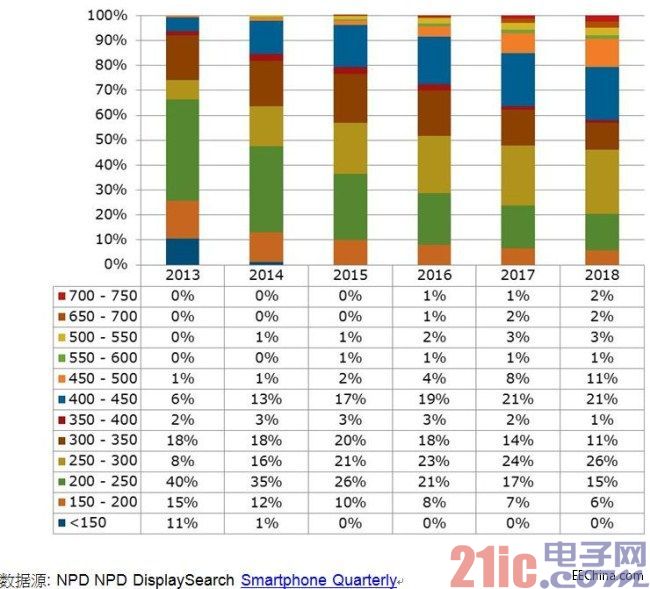NPD DisplaySearch Shanghai Office, August 14, 2014 --- According to NPD DisplaySearch's second quarter smartphone report (Smartphone Quarterly), low-end smartphones will reach 37% market share in the global market in 2014, estimated to be 2018 Up to 46%, the proportion of mid-level smartphones will also grow from 29% to 32%; the relative high-end smartphones will decline from 33% to 22%. In other words, mid-to-low-end smartphones with high-resolution smartphones will reach 78% of all smartphones by 2018.
This article refers to the address: http://
NPD DisplaySearch defines low-end smartphones for US$200 or less, and then carefully analyzes low-end smartphones, although the price is lower, but it does not mean that the product or display specifications are lower. NPD DisplaySearch is based on smartphones in different regions. The display size and resolution are analyzed and compared in detail.
For most of Asia (excluding Japan), Latin America, Eastern Europe, the Middle East and Africa, which are still developing countries, NPD DisplaySearch analyzes the size and resolution of smartphone displays in these regions, with PPI (Pixel Per Inch) As indicators, it is found that the mainstream PPI for smartphone displays will be 200-250 PPI in 2013 in these regions, and the mainstream PPI in 2018 will be 250-300 and 400-450. This means that the mainstream of smartphones in emerging regions will be upgraded from 3.5†HVGA (480x320) and 4†WVGA (800x480) to higher specifications, and future 5â€-5.5†HD (1280x720) and FHD (1920x1080) displays. It will gradually become the mainstream specification for smartphones in emerging regions.
According to NPD DisplaySearch, however, product prices continue to drop in emerging regions. For display-related supply chain manufacturers, in addition to continuously pushing up product specifications, they must also consider how to reduce costs, except for panels above the fifth-generation line. In addition to the production of smart phone panels for higher economic efficiency, how to integrate other materials and increase the penetration rate to reduce the cost of backlight materials is the focus of future development of smart phone displays, and these are currently emerging by display-related manufacturers. The strong growth of the region is the direction of efforts.
Li Xiaolin, research director of NPD DisplaySearch, said that in addition to Japanese panel makers, LTPS (low temperature polysilicon) and IGZO (metal oxide semiconductor) technology are the focus of development of smart phone displays. Taiwan and China panel makers, Korean panel makers are also beginning to increase the five-generation line a- Si (amorphous silicon) production capacity for low-end smartphone displays. Since the resolution requirements of low-end 4G LTE smartphones for the future are HD (1280x720), it means that the fifth-generation line can produce panel-scale production. Economic benefits are also conducive to cost reduction.
At the same time, the panel factory will increase the development progress of On-Cell and In-Cell more quickly. Although panel manufacturers have been actively investing in the production of external touch panels in recent years, they are still not in the mass production of professional touch panel factories. The price cuts, so the development of On-Cell and In-Cell will help the panel factory to have more competitive advantages, including price and product integration, which is the driving force for many drivers and touch IC manufacturers. However, the price cuts of low-end and mid-range smartphone products are too severe, and the integration of touch and display faces more challenges.
NPD DisplaySearch also pointed out that although the price of low-end smartphones is rapidly decreasing, it does not mean that the development of monitor specifications will be stagnant, and the PPI of low-end smartphone displays will continue to develop more precisely. However, there is still a limit to the a-Si (amorphous silicon) technology, although more processes can be added to complement the a-Si (amorphous silicon) deficiency, but it will also increase the cost of the product and reduce the production yield. In order to produce high-resolution panels in a-Si (amorphous silicon) capacity, in addition to investing in and improving the process capability of existing machines, panel makers and IC manufacturers are actively investing in the development of Sub-Pixel Rendering. , including Rainbow Rendering, which is expected to add more backlight penetration in high-resolution displays, in addition to reducing the cost of the backlight module, while also improving the high resolution a- The yield of Si (amorphous silicon) displays, which in turn reduces production costs.

Analysis of the development trend of PPI (Pixel Per Inch) in smartphone display in emerging regions
Thc oil vaporizer
Shenzhen Yingyuan Technology Co.,ltd , https://www.yingyuanvape.com